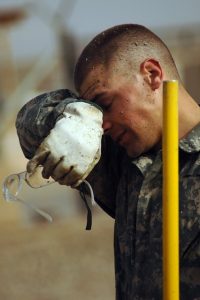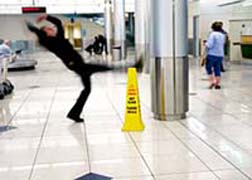 High heat and construction work are simply not compatible. Yet, the work must get completed. Workers must wear protective clothing and gear which diminishes the body’s capacity to shed heat. This fact combined with high heat creates specific exposures which require vigilant monitoring.
High heat and construction work are simply not compatible. Yet, the work must get completed. Workers must wear protective clothing and gear which diminishes the body’s capacity to shed heat. This fact combined with high heat creates specific exposures which require vigilant monitoring.
Short-term exposures to heat and humidity:
- Prevention: Drink plenty of water – a good test is the employee must urinate every three hours at a minimum, two hours is better. If they do not need to urinate, they are not getting adequate fluids. Wear breathable clothing such as cotton. Work in the shade or indoors as much as possible, take frequent water breaks in the shade.
- Heat exhaustion: the stage prior to heat stroke when many symptoms from dehydration can be noticed. Any dizziness, nausea or vomiting, cramping, or sudden weakness requires immediate attention. Headaches, blurred vision or unusual fatigue can be signs of heat exhaustion. Rest the worker in the shade, loosen tight clothing and provide water. Observe the employee for several minutes. If they quit sweating or any symptom becomes worse, or they breathe rapidly or have a quick pulse, seek emergency medical help immediately.
- Heat stroke: LIFE THREATENING. Add these to the heat exhaustion symptoms:
- Hallucinations, confusion, disorientation, illogical behavior
- High body temperature, red or pale skin, difficulty breathing
- Unconsciousness or coma
Seek immediate professional help for these symptoms.
Bacteria carrying insects love this weather. Lyme disease and West Nile Virus are not uncommon. Prevention includes spraying mosquito deterrent and checking for ticks.
Long-term exposures include skin cancer. Wear protective clothing and use sunscreen.
Common sense goes a long way to prevent over-taxing workers. If a concrete pour is scheduled for an extremely hot day, postpone. You’ll spare your employees heat related discomfort, and the odds of getting the concrete in before it sets is remote at best.
Remember your machine operators too. Check on them throughout the day and carefully observe their performance. Any signs of erratic behavior needs to be addressed immediately. Even air conditioned cabins can create dehydrating condition in the hot sun.
If you want your crew working Friday, you need to supply plenty of water and shaded rest breaks Monday through Thursday. The body can only take so much heat.












